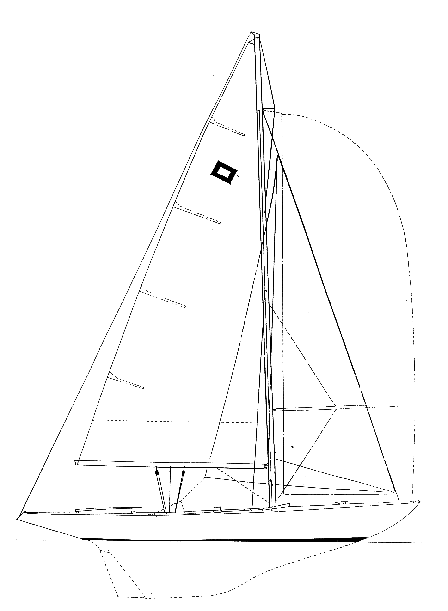Piper 24
One Designr
It's time for another yachting history lesson. Sit up straight, spit out your gum and pay attention. This is important.
In 1938 a young Scottish designer named David Boyd made his mark with the outstanding 6-meter Circe. Circe came to the United States to face the fastest of the American 6s, the famous S&S-designed Goose, in the Seawanhaka Cup. Circe did beat Goose, and Mr. Boyd's career was well on its way.
In 1958 the British challenged for the America's Cup in a David Boyd-designed 12-meter called Sceptre. They lost to the venerable S&S-designed Vim. In 1964 they again challenged with another David Boyd boat, Sovereign. They lost again, although to my youthful eye they won on style points. Sovereign had teak decks and a graceful sheer even if it did receive a drubbing at the hands of Constellation, the S&S twelve. (We did a lot of drubbing in those days.) I relied on my old pal and yachting historian Scott Rohrer to fill in the blanks on this background material. Sovereign was the last I heard of the tall and elegantly handsome David Boyd. Until now.
In 1966 Boyd designed the Piper class for fiberglass construction and one-design racing on the Clyde. All told 57 Pipers were built. In 1985 a moss-covered and neglected Piper was discovered by Frank Collam, the builder of the Cornish Crabber line. Collam saw through the grime and verdigris and recognized a classic. Plans were made with the Cornish Crabber yard to start a new fleet of Pipers. The look and mood of the little Piper fit right in with the Cornish Crabber yard's style of building.
The S&How can you not love this boat? It looks like a mini version of the Boyd 12-meter Sovereign. It has the overhangs, the sheer and the cutaway full keel with attached rudder. With an LOA of 24 feet, 5 inches the overhangs reduce the DWL to a scant 16 feet, 3 inches. The D/L is a whopping 370. Approximately 59 percent of the displacement is in lead ballast, carried low and encapsulated in the keel. I would imagine that the Piper is quite stiff.
These overhangs don't do much if anything for boat speed, but they certainly are beautiful. If you compare the quarter buttock angle at the DWL (you can use the hull profile angle if you like) of the Piper with that of a modern racing yacht you will see that this angle is much steeper on the Piper. If there is anything to be gained from an overhang it must be kept closer to the water at a less steep angle where it will immerse at moderate angles of heel. Piper looks great from any angle.
The rig is a moderate-aspect-ratio fractional type that has been modernized with an adjustable rigid vang and a roller furling genoa. The 5:1 mainsheet is fixed on a thwart just above the cockpit sole. The genoa winches appear to be either the old-fashioned, bottom-action type with the handle below the deck or maybe just snubbing winches without handles. The genoa lead is a "twinger" type arrangement that is adjustable under the deck. The SA/D is 15.1 using the company's figure of 220 square feet for the sail area. I don't know if this includes the area of the genoa or is based on I, J, E and P.
The deck design features a smallish, deep and non-self-bailing cockpit. The intended crew is three, but this cockpit looks tight for three. The brochure calls the Piper a "sit in" keelboat, but almost all the photos show the crew sitting on the side deck. This is fine except for the fact that there is a two-inch teak coaming around the cockpit that would bite into the back of your thighs eventually. There is a teak splash guard forward of the mast to help keep water out of the cockpit. I think in any chop at all you had better wear your foul weather pants or you will soon have a wet seat in this ride. The low freeboard, while beautiful, would make this deck a damp sitting area.
The Piper 24 is one of those boats that I think would be ideal for teaching the grandchildren about sailing. You are not going to tip over. The kids won't tumble out of the deep cockpit. And you will be introducing your little darlings to sailing in a style that will bring them into contact with the timeless aesthetic of yachting.

Comments